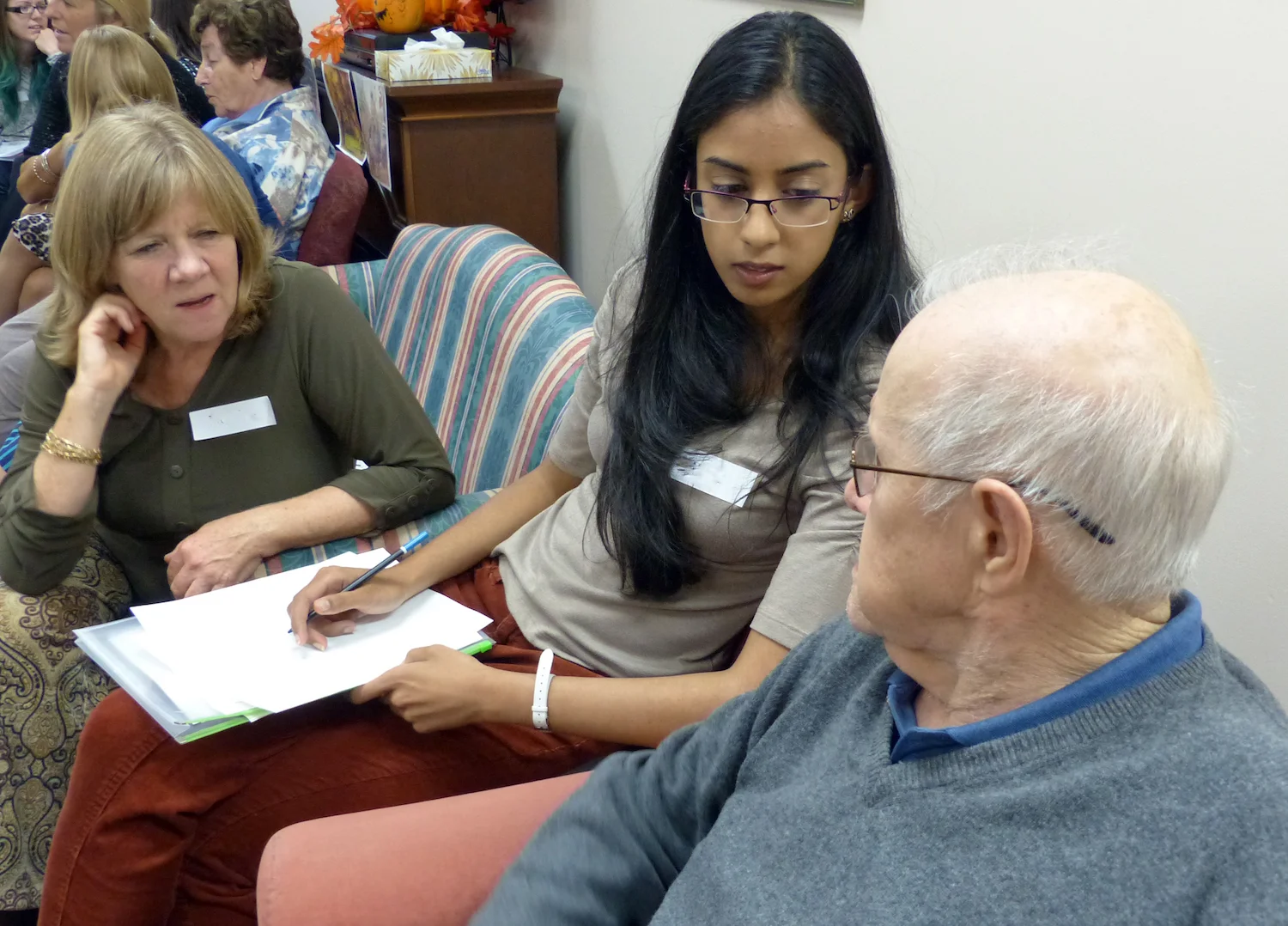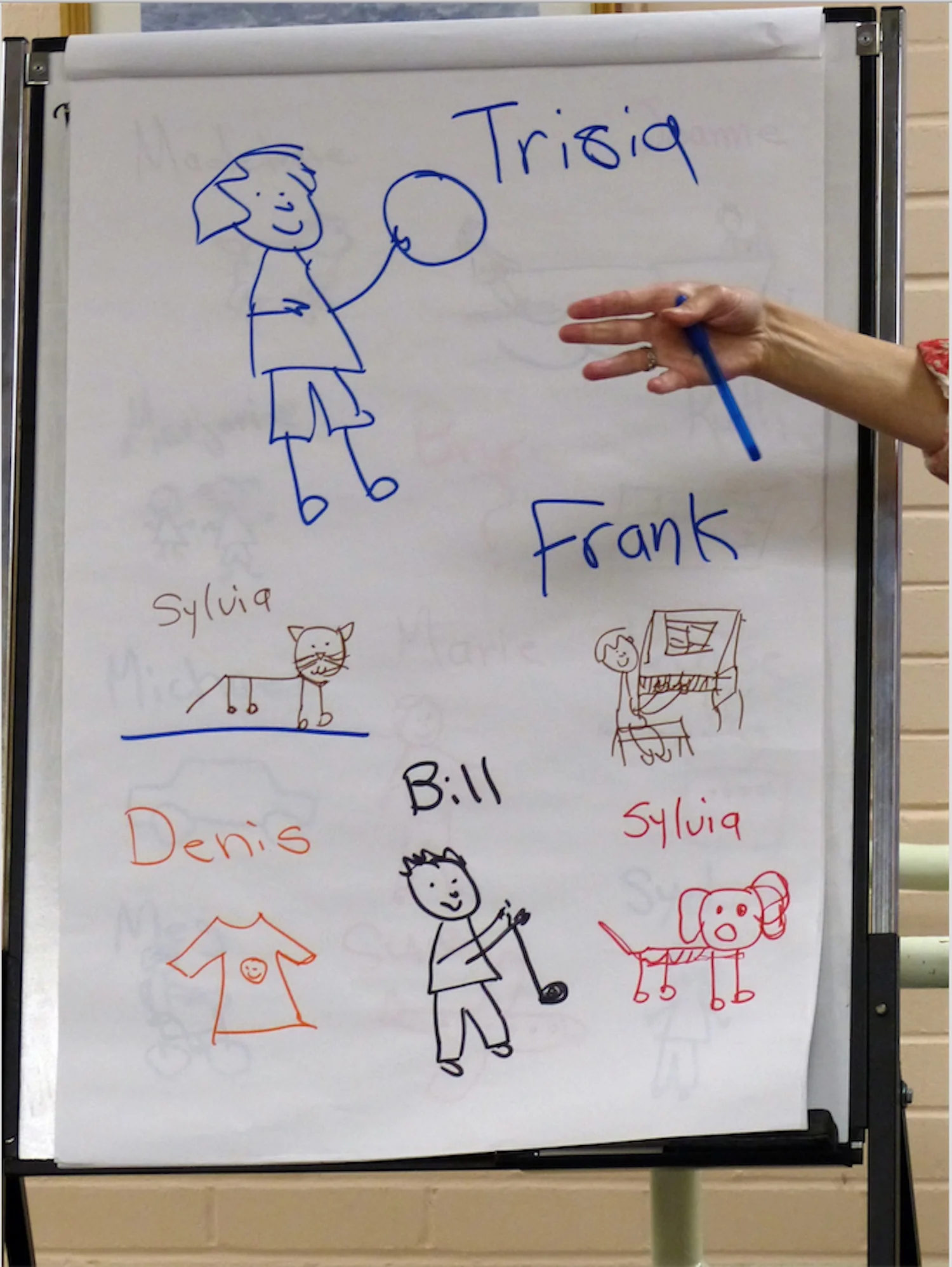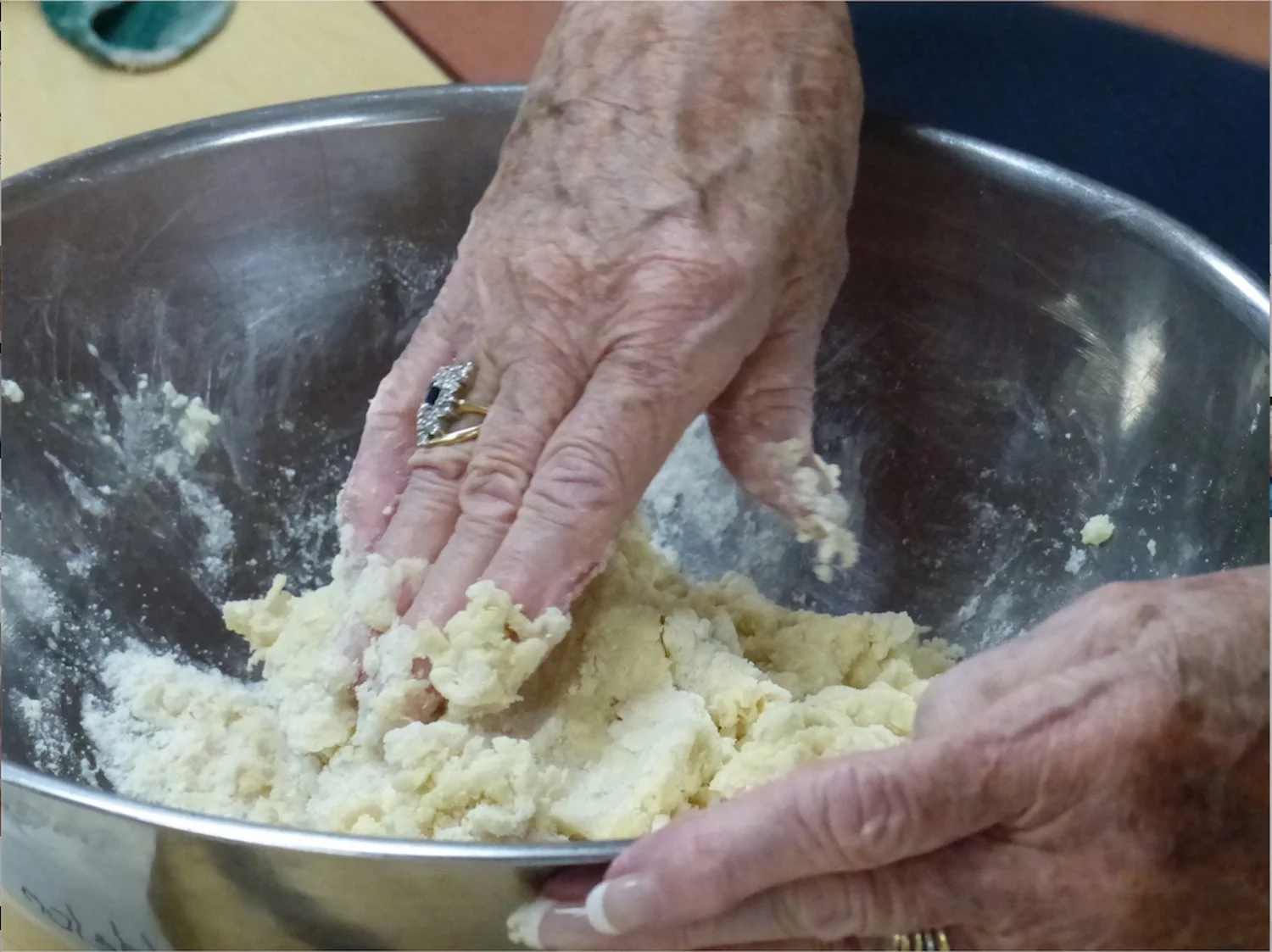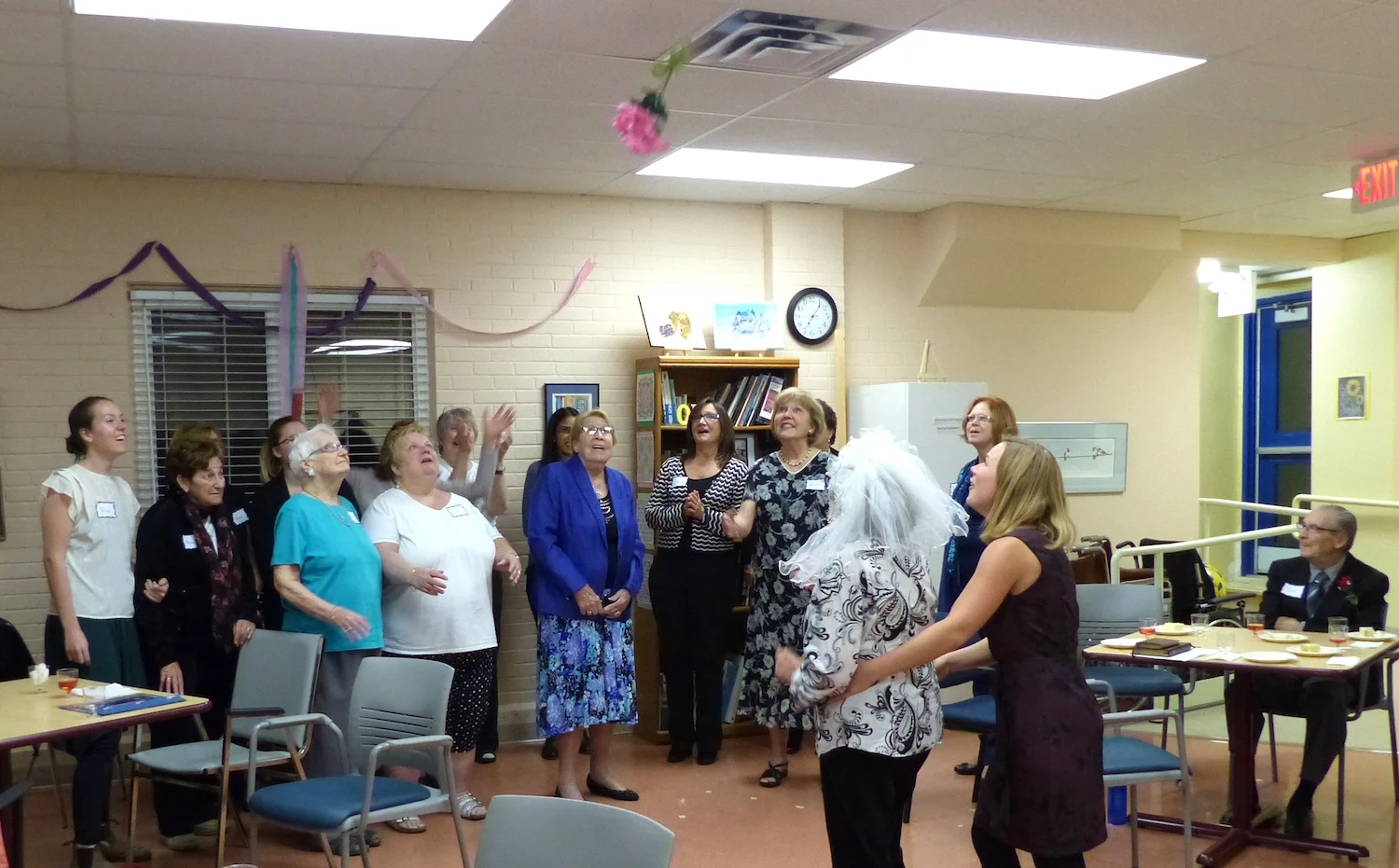'Remembering Yesterday, Caring Today'
'Remembering Yesterday, Caring Today' (RYCT) is a creative arts reminiscence program designed by Pam Schweitzer for families who are caring for a relative with dementia at home.
The program has been running since 1997, and is currently offered in 10 European countries.
In 2015 we launched the very first 'Remembering Yesterday, Caring Today' program to be held in Canada at Carefor Health & Community Services Carling Day Program in Ottawa, Ontario. Nine families participated in a series of 12 weekly reminiscence sessions, with professional and volunteer support.
Below we illustrate key features of the RYCT approach (Schweitzer and Bruce, 2008, p86) with photographs and anecdotes from our Canadian program.
Key features of the RYCT approach
Working in ways that enable people with dementia to participate fully in reminiscence work, and to feel valued and fully included
A team of dedicated and enthusiastic volunteers joined me (Christine) to launch the RYCT program in Ottawa. Team members received a training in reminiscence skills and arts-based methods of communication and were guided to put these skills into practice as they accompanied families over the course of twelve weekly sessions.
During the First homes session Frank and Fériel worked collaboratively to draw Frank's memory of being newly wed and becoming a 'handy hubby'! Fériel's delightful drawing of Frank in action made it easier for Frank to then share his unique sense of humour with the rest of the group!
Using a structured approach to reminiscence and activities that stimulate all the senses to trigger memories
The weekly sessions were based on key stages in life and arranged chronologically.
Week 11: Travel
Travel was a particularly engaging session. With Montréal's Expo 67 in mind, team members each prepared a 'pavillion' showcasing a country or group of countries known to one or several of the group members. There was plenty to look at, touch, taste and smell, triggering memories for some and providing new stimulation for others!
For our reunion in January, I (Christine) put together a video presenting highlights from our own Carling Expo 15 to the jazzy sounds of Glen Miller's Chatanooga Choo-Choo. Enjoy!
Carling Expo 15
Making use of the creative arts - music, sound, visual arts, photography, dance, movement, writing and drama - to give added value to stories told, to facilitate full use of non-verbal expression, to provide outlets for creativity and humour and to create a 'doing' atmosphere
During large and small group activities we used a variety of creative approaches and arts media to trigger, record and share memories.
To begin our Childhood session, group members were invited to survey a colourful collection of toys and games, arranged on a large table, and to choose something reminiscent of their childhood. Team members and families then sat together in small groups to share their memories.
Bruce chose the baseball mitt and ball to tell a story from his childhood in Matachewan, Northern Ontario. In the small group, Sarah recorded his memory in writing. When Bruce re-told his story in the large group, she captured his memory again, this time in a drawing for all to see.
“When Bruce was a young boy he was chosen to play in the men’s baseball team. While he was practicing his pitching in the garage, he accidentally threw the ball too hard and put a big dent in the garage door. He mentioned that it was a very nice garage door that his father had worked on. Whoops!”
The baseball mitt and ball made it possible for Bruce to show his pitch to the group in a spontaneous re-enactment of the event! We all gasped, but no dented doors to report!
“The session I most enjoyed had to be Childhood and my baseball story. I got so many breaks in life.. What you’re doing here makes people think and helps people see things in the best light. I’ve tried to do that all my life. Right now, with my physical and mental situation, I’m at home alone. What can I do all by myself? This gets my thoughts back in to a normal thinking and acting situation.””
Creating opportunities for interactions and activities that enhance the well-being of participants with dementia
The RYCT program includes separate time within selected sessions for family caregivers to meet together with the program facilitator. This provides an opportunity for caregivers to reflect on their experience and discuss ways to continue the reminiscence activities at home. Splitting the group also creates an occasion for participants with dementia to get to know one another and to work together as a team.
For our ninth session, the topic was Food and the activity was baking. As family caregivers retired to another room, everyone else rolled up their sleeves, put on an apron and got busy!
“When I asked Helen and Syd what their favourite session was they both said ‘Oh, we loved all of them..’ But then Helen said, ‘You know, when they told us we would be baking, I was so worried, but as soon as I got my hands in there, I knew exactly what to do.’ She expressed this to her family and the following week, Helen and her daughter-in-law baked scones for breakfast!”
As they practiced former skills, participants bonded with one another in new ways.
“At the end of the night, when everyone was getting ready to leave, Helen went up to Mary, touched her cheeks, and said very cheerfully, ‘Wasn’t that fun today baking together!’ It was a very sweet moment between them.”
Sharing common experience and celebrating differences
On a number of occasions during the program, we organized whole group enactments, rearranging the room to resemble a one-room schoolroom (week 4), a dance hall (week 6), a church wedding (week 7) and a world trade fare (week 11). These 'as if' re-enactments of common experiences brought everyone closer together.
The bride throws her bouquet!
For the Weddings session, for instance, a husband and wife team, happily married for 60 years, kindly accepted to get married (again!). As you can see, we were all invited, and a good time was had by all!
“By recreating familiar past situations in the present, we are enabling people to call on their personal lived experience and to participate as equals in bringing these situations alive.”
Having a supportive attitude to family carers and their relationships with those they are caring for, whether or not family carers are actively involved
In their program evaluations, family caregivers wrote about the support and fellowship they experienced in the company of other families; the kind, open and receiving attitude of team members; and the fun they and their spouse or parent had remembering together.
“I saw my husband as he was before he became ill. We were a couple, having fun, just like the old days.”
“Both my mother and I looked forward to coming out on Tuesday evenings because we had so much fun. This program gave me an opportunity to spend more time with my mom. It brought us closer together.”
“We met such a wonderful group of people, shared experiences, both funny and emotional, and always left feeling happy and uplifted.”
When working in groups, giving participants the opportunity to get to know one another by working together, providing a sense of belonging and friendship at a time when this is particularly necessary
In their program evaluations, participants with dementia mentioned how good it was to be with people, to learn about people's lives and to see people laughing and having fun.
“We thought about things we wouldn’t have thought about on our own. When doing this, we developed a bond together. No one ever felt left out. We all felt like we belonged.”
Bibliography
Schweitzer, P. (2007) Reminiscence Theatre: Making Theatre from Memories. London: Jessica Kingsley.
Schweitzer, P. and Bruce, E. (2008). Remembering Yesterday, Caring Today. Reminiscence in Dementia Care. A Guide to Good Practice. London: Jessica Kingsley.
For a detailed account of the RYCT program and its history, visit http://www.rememberingtogether.eu.
A number of the artifacts shown in these photographs were loaned courtesy of Museums Ottawa.


























